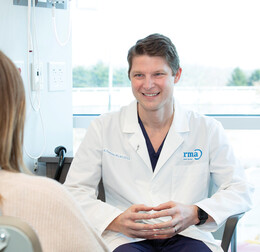
A Most Precious Gift
RMA Marlton prioritizes safety in its quest to aid patients’ struggles with infertility and produce positive outcomes for mom and baby.
They say no love quite compares to the love a mother has for her child. Most mothers would say they would be willing to make any sacrifice for their children. For some, however, biology stands in the way of helping women achieve the goal of starting or adding their family. Often, the desire to realize this bond becomes so great that a mother will do almost anything to have a child, including pursuing modes of treatment that might jeopardize her health.
Safety should be a priority for overcoming one’s infertility struggles, according to Emily Osman, M.D., FACOG, a reproductive endocrinologist and infertility specialist with RMA Marlton. Due to groundbreaking advancements made by practitioners such as Dr. Osman and her fellow RMA physicians, no woman should ever feel that becoming a mother requires taking an unnecessary risk.
“We want to enhance patient outcomes in a way that results in healthy moms and healthy babies,” she says. “The way we practice fertility medicine is designed to optimize safe outcomes for moms and babies. Growing families safely has been the foundation by which we have practiced from the very beginning. Everything we do is designed to enhance outcomes while minimizing neonatal complications and risks, and that begins with transferring only one embryo at a time.”
Clinical studies have shown that when paired with preimplantation genetic testing, a single embryo transfer can result in an ongoing pregnancy rate equivalent to transferring two untested embryos. Single embryo transfer, studies show, also reduces the risk of multiple gestations (i.e., twins) and the potential complications that come with it. Dr. Osman cites the BEST (Blastocyst Euploid Selective Transfer) trial, conducted at RMA and published in a 2013 edition of the peer-reviewed medical journal Fertility and Sterility.
“This randomized controlled trial compared the results of transferring one embryo versus two, and also studied the role of preimplantation genetic testing,” she adds. “It shows that transfer of a single genetically normal embryo results in ongoing pregnancy rates that are the same as transferring two untested embryos while significantly reducing the risk of twins. With two embryos, the risk goes up astronomically. Those patients who conceived twins had significantly higher rates of preterm delivery, infants with low birth weights, higher NICU admission rates, and significantly longer hospital stay for the mother.”
Dr. Osman, who joined RMA Marlton in 2020, underwent preimplantation genetic testing and an in vitro fertilization cycle at a sister RMA New Jersey facility. The results: She welcomed her second child, a girl, into the world in the summer of 2020. We spoke with Dr. Osman at length about single embryo transfer, among other factors that prospective patients should keep in mind as they build their families.
Q&A
At RMA, single embryo transfer is now the standard of care. Why is this an important distinction?
At RMA, single embryo transfer is now the standard of care. Why is this an important distinction?
We made this change in 2018, and the decision was made because we found that transferring a single embryo did not compromise pregnancy rates. The crux of the matter is the number of babies resulting from the transfer of a single embryo versus multiple embryos. With two embryos, the risk of having twins multiplies, obviously, increasing the risk of unwanted obstetrical outcomes. Our IVF success rates are so good, in large part because of the preimplantation testing we do, that there is no need to put more than one genetically normal embryo.
In the past, we have written about SART, or the Society for Assisted Reproductive Technology, which reports on clinics’ success rates in helping their clients achieve pregnancy, among other metrics. SART’s website (www.sart.org) recently published its newest IVF success rates, where RMA’s mean number of embryo transferred for all age groups was one, compared with the national average, which was significantly higher. Why should those numbers be important to people who are vetting clinics for help in solving their infertility issues?
When couples struggle to have a baby, they want to maximize their chances of success, and they want to do whatever they can from the get-go to optimize their likelihood of having a baby. Some of the higher numbers you’re referring to are practice-driven because there is an inclination to place more than one embryo if those embryos have not been genetically tested. Some of it is patient-driven, meaning patients are actually requesting to have more than one embryo implanted because they think that will increase their success rate, and the clinic does not counsel them otherwise. For us, it all comes back to safety. The worst thing we can do is put patients in a situation that compromises their health or the health and well-being of their children.
Besides championing patient safety, RMA has been a leader in other ways, through pioneering research to further refine techniques designed to help patients build their families. It’s easy to understand why research that has been published in peer-reviewed medical journals would appeal to other physicians in fertility medicine, but why should that matter to the consumer?
Simply put, groundbreaking research leads to better outcomes for patients. We talked about the BEST trial, a sentinel study showing the benefits of single embryo transfer and preimplantation genetic testing. A subsequent study published in the American Journal of Obstetrics and Gynecology showed how a singleton pregnancy increased the likelihood of a lower rate of maternal admission, a shorter length of stay, and a better overall experience for mom and baby. For us, we have realized through the optimization and validation of our genetic testing platform that we can offer enhanced reproductive efficiency. When we implant a genetically normal and healthy embryo, we have at least a 65 percent chance of achieving a live birth.
At RMA, we emphasize the ability to provide a quicker time to a healthy pregnancy and safe delivery. Our goal is to prevent adverse neonatal outcomes and reduce the risk of preterm birth. We also want to work with patients to optimize comorbidities like high blood pressure and diabetes to enhance reproductive outcomes. By helping mothers become healthier as they prepare for pregnancy, we can lower their risk of miscarriage and increase the chance of having a baby carried to full term and delivered in good health and at normal birth weight.
When a consumer considers fertility treatment, the insurance coverage will likely play a significant role in the outcome. What does a consumer need to know as it relates to insurance?
Some insurance companies are now mandating single embryo transfer. They have moved in this direction because there is a cost associated with twin gestation, as well as the cost of prolonged maternal complications. It’s a considerable amount of risk associated with putting multiple embryos back. My hope is that other insurance providers will follow suit by realizing single embryo transfer not only helps patients but is much more cost-effective in the long run.
All of us fertility doctors have had obstetrics experience, and most of us have delivered very preterm twins or low-birthweight twins. Some [of those twins] have not survived, but even for those who do, there is a higher risk of cerebral palsy, cognitive delay, ocular disorders, failure to thrive, and cognitive disabilities. It’s heartbreaking when you see patients work so hard to start a family deal with such an unfortunate outcome. We want to save patients from going through that, so we work so hard to promote singleton pregnancy. Having a baby is an incredibly rewarding experience, but it can be particularly trying when it results in an unwanted outcome because of risks that could have been minimized.
For anyone who may be considering an infertility specialist to help them grow their families, is there anything else they should know that might help them make good decisions in the future?
Be an informed participant. Ask the clinic what their success rates are. Ask what the differences in pregnancy rates are between placing one embryo versus two, and ask what the risks are to mom and baby. With single embryo transfer, we are striving toward placing one genetically normal embryo to give the patient the best chance of having a healthy singleton pregnancy that results in a healthy baby. Patients need to be informed, and they also need to participate in their care. Here at RMA, we do everything we can to make sure patients are fully informed and involved in every step of the process.
For more information on RMA Marlton, visit rmanetwork.com or call (856) 267-8100.












